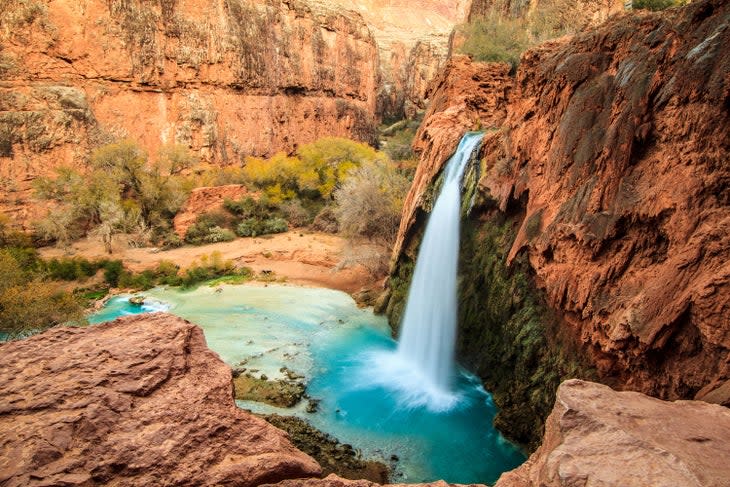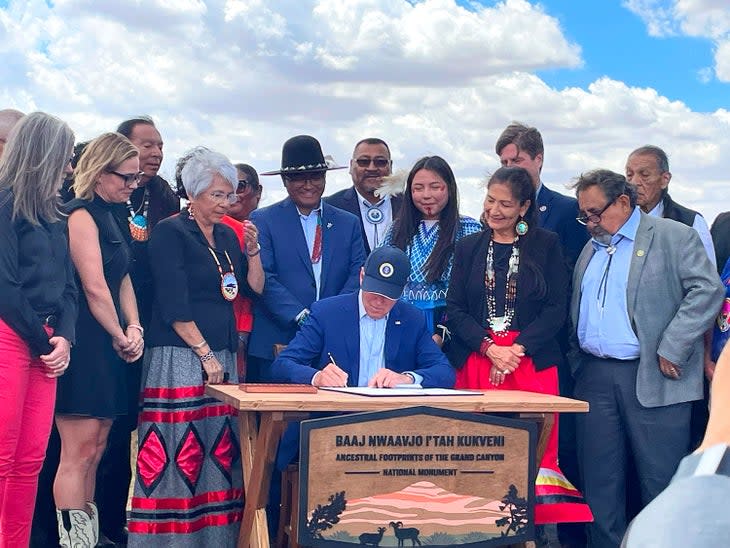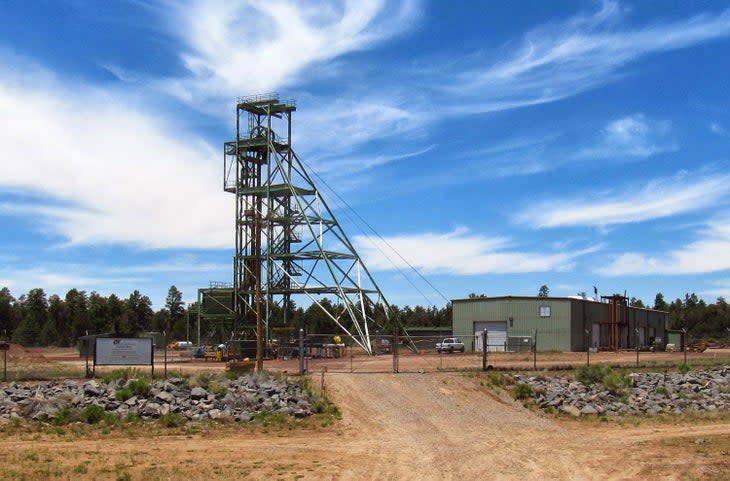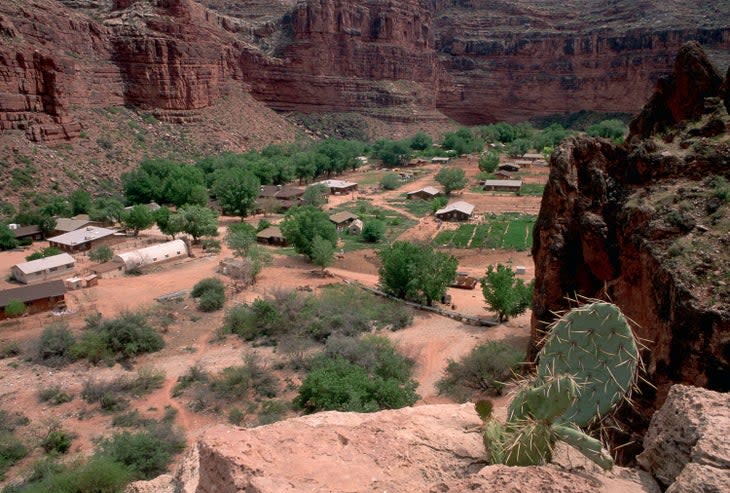Finding Hope on Stolen Lands: Arizona’s New National Monument
This article originally appeared on Outside
On a hot July morning, I wryly text, "I'm going to a big hole in the ground" to a friend and head off to the Grand Canyon, assuming that I knew what I was getting myself into, my rental car speeding and zig-zagging through the hills from the mountainous town of Flagstaff to Grand Canyon National Park. Everything is orange and pink, and the heat is rising. I get to the south gate, grab a cup of coffee, and prepare to be amazed.
And...I am. I'm not an "outdoorsy" person. I'm not someone who likes to pontificate about nature like it's a separate, ethereal monolith; a place you visit and then remove yourself from when you re-enter city limits. Much ink has been spilled on the glory of the Grand Canyon and, without the pretense that I am being partially novel or unique, the place is glorious. I sit and hold my own little communion with the land, sketch in my notebook, and almost pass out because I don't want to step away from the gorgeous view for a drink of water. It's breathtaking stuff, and I'm immediately embarrassed about calling it "a big hole in the ground," even as a joke.
Taking it all in, I found it easy to become horribly angry.
Most who came to the park on that sweltering July day were just visitors, passive interlopers ready to consume the sights and be on their merry way. The place inspires such intense feelings in the most casual visitor; I can't imagine how deeply connected tribes like the Havasupai are to this place. I start thinking about how many tribal members still live at the bottom of the Grand Canyon in a town called Supai, where their ancestors are buried and the Colorado River that runs through the red rock is the only water source. Up on the rim, there is a sense that the park is tacitly aware of its colonial history. Information is available at stations and on plaques describing some of the tribes who have ancestral ties to the land. But, to me, it feels pretty sterile. I start to seethe even more.

On August 8, 2023, a few weeks after my visit, the Biden administration federally codified the efforts of Indigenous tribes to protect almost a million acres surrounding Grand Canyon National Park and established Baaj Nwaavjo I'tah Kukveni--Ancestral Footprints of the Grand Canyon as a national monument. Three sections of the national monument butt up against-and at points encompass-the Kaibab National Forest, plus the eastern edges line the boundaries of the Navajo Nation. Baaj Nwaavjo (Bahj-Nuh-Wahv-Joe) means "where tribes roam" in Havasupai and I'tah Kukveni (Ee-Tah Ko'oo-Veeni) means "our footprints" in Hopi. During his announcement President Biden spoke of his first time seeing the Grand Canyon: "This is God's cathedral is what it reminded me of. It's just so magnificent."

Following the example of Bears Ears in Utah and Spirit Mountain in Nevada, this new generation of national monument aims to give tribes a seat at the table. Advocates say Baaj Nwaavjo I'tah Kukveni will save the land from extractive energy industries, protect sacred places, and create a more concrete relationship between the National Park Service and the tribes. My gut tells me to not become too comfortable, and that the federal government will use any excuse to sidestep actually giving the tribes their due.
I get more and more worked up thinking about how the table belongs to the tribes: the table, the room, and the whole house. The land is stolen and belongs to the Indigenous people who have lived here for thousands of years. I feel such disconnect going to spots like the Grand Canyon. There's this self-assured confidence in the air with places that the U.S. has colonized and repackaged for settlers who want an "outdoorsy" experience. Perhaps when I called the Grand Canyon a "big hole in the ground," I was being defensive. I have too much experience being in beautiful places that have been scrubbed clean of their Indigenous ties, or worse, co-opted to sell something. I've wept in the middle of bougie ski towns in Colorado, rolled my eyes at flaccid land acknowledgements in Montana, and gawked at the racist comments against Indigenous people in Wyoming. The very premise that tribes have to fight the U.S. Government for permission on what to do with their land makes my skin crawl. So, me and the outdoor settler industry have been at odds. My hands ball up into little fists as I think about it.
Will Tribal Co-Management Become Reality?
I've covered Indigenous affairs for several years, mostly in Wyoming on the Wind River Reservation, and it leaves a bad taste in my mouth when a writer drops in for a day or two and then thinks they've gleaned some primal knowledge from the experience. I'm Arapaho and Shoshone and...I hate to break it to you, but just visiting a place does not give you special access, or a promo code to the land. When I visited the Grand Canyon on that July day, I remember thinking, I'm no better than the tourists who come to places like this for a day, then I'll go home and write an article, and then what? The kicker was that when the Biden Administration approved the national monument a few weeks later, my first thought wasn't, "Hooray!" it was, "Let's see how the federal government messes this one up."
Official agreements from the federal government to facilitate tribal co-management of public lands like this are still relatively new. Tribes have had to rely on the political whims of different administrations over the past decade at spots like Bears Ears National Monument in Utah to see if the fate of ancestral lands will end up in their hands. Now there were actual documents with teeth to point to, but still I was not convinced. The weeks after the national-monument proclamation was probably when my cynicism was at its peak.
In 2016, President Obama established Bears Ears National Monument, and the Bears Ears Inter-Tribal Coalition, made up of the Hopi, Zuni, Ute Mountain Ute, Dine, and the Ute Indian Tribe, was created as a unified entity to protect the natural and cultural resources of the monument. After the whirlwind shrinkage and subsequent reallocation of the monument, the coalition released a management plan in 2022 as a guiding document to provide a "synthesis of Tribal perspectives" on how to manage important issues like livestock grazing permits, and meaningfully address climate change, tourism, and extractive industries. Like that at Bears Ears, a co-management plan is in the works for Baaj Nwaavjo I'tah Kukveni, but one major obstacle remains in the way, and was a predominant reason in the founding of both national monuments: protection from energy development.

According to the Grand Canyon Trust, currently there is a uranium mine in development six miles from Grand Canyon National Park's south entrance called the Pinyon Plain Mine (formerly the Canyon Uranium Mine). The mine is now on the new Baaj Nwaavjo I'tah Kukveni National Monument, but despite the protections the land's designation should afford, it is unclear if the mine will be active in the future. Advocates say that continued mining near and around the Grand Canyon is due to an archaic federal mining law from 1872 that allows for U.S. public lands to be easily explored for minerals. Last year, the federal government had a hearing on reforming the General Mining Law of 1872, highlighting the importance of updating the language with tribal nations in mind, but no further action has been taken. Over the years, courts have found that Energy Fuels-the owners of the Pinyon Plain Mine-have a standing claim, despite the 20-year moratorium that began in 2012 blocking new mining claims around the Grand Canyon, specifically to protect it. Uranium mining comes with a host of issues including a huge environmental risk that bleeds over into health risks, disproportionately affecting Indigenous people. It can poison the land, can corrupt precious water supplies, and is linked to high cancer rates on the Navajo Nation where the Dine live.
One of the big players in the fight for this land is Carletta Tilousi, a former Havasupai council member and currently with the Grand Canyon Tribal Coalition, the group that originally proposed the national monument. "You can see the canyon breathing," Tilousi says over the phone, looking up from the bottom of the Grand Canyon in the village of Supai where she grew up. Nestled in the crevices of the Grand Canyon beyond the borders of the national park, the tiny Havasupai town-population approximately 200-has a church, an inn, and a store/cafe. Towering red walls rise on all sides, with a vein of turquoise water snaking through the canyon, carving up this renowned world wonder that you've probably seen splashed across your Instagram feed. Tilousi also points to the General Mining Law of 1872 that allows for energy companies to easily access public lands, and since Supai's only water is in the Grand Canyon she wants to protect it for future generations.

"A lot of tribes have a really strong connection to the Grand Canyon, and 13 other tribes have joined the Havasupai to stop any further contamination of the waters," she says about the coalition that helped form the new national monument. She goes on to talk about the Orphan Mine that poisoned Horn Creek, downstream from Supai, with uranium before its closure in 1969. To this day, it's still unsafe to drink water there due to radioactivity. Tilousi never wants to see that happen to her home again. She remembers being a teenager in the 1980s when she first heard of the possibilities of uranium mines contaminating Havasupai's only water source. The realization that her home-the very red rock and blue water she was raised in-was under attack stuck with her for decades, and for much of her life she has been fighting against institutions that put the river, and her people, in danger.
A Vision of Hope
I called Carletta again in September, after the buzz of the new designation had faded. Her voice was like wind chimes, and I asked what she wants out of a co-management relationship. "It's not only just a tribal issue, we want to include everyone. The residents of Arizona and outdoors people, they want to enjoy the beauty of the canyon in peace," Carletta said, and it sounded like she was smiling. "There's people from all over the world looking at the canyon in wonder! This should be owned by everyone." She continued by saying she loves talking with tourists, and sharing her home with so many from around the world. "It's a lot of meetings and collaborations, pen on paper, but we are committed," she said. "It's there in black and white...I never knew I would see this in action in my lifetime...quite frankly." As I hung up the phone, I felt tears collecting on my cheeks. Tilousi had shared her whole fight with me; her decades-long journey had led to the protection of the land she loved so dearly. She told me that when she was a little girl she wasn't allowed to collect medicines, like pinyon, in her ancestral forests, and she never thought she would see the day that the land surrounding the Grand Canyon would be protected like this. It's a major stepping stone for tribes everywhere, and especially those in Arizona. I began to realize that my anger had clouded my ability to see that.
The management plan has not yet been released for Baaj Nwaavjo I'tah Kukveni outlining the ways tribal co-management will work, and in what ways the U.S. will make good on their promises. The reformation of the 1872 mining law is the first thing that needs to happen so that lenient energy policies don't endanger sacred tribal sites. This includes the Grand Canyon, of course, but the land surrounding the canyon is also worthy of protection. Driving on U.S. Hwy. 64 through part of the almost one million acres of Baaj Nwaavjo I'tah Kukveni is breathtaking, and not just because of the intense heat, but because the rolling hills, cacti, firs, pines and cottonwoods all deserve protection too. The flora and fauna that call the place home, the bugs that pollinate the plants, and the dirt that has been there for thousands of years all stand as testament to the momentous decision to protect the land from deadly mining claims. If the new designation does not permanently stop mining around the Grand Canyon, it doesn't go far enough to save these sacred lands. But I have faith that with meaningful tribal input, the Indigenous folks there will do what they do best: protect.
Bitterness had really robbed me of enjoying my day at the Grand Canyon. It was beautiful, who could deny, but an undercurrent of resentment threaded throughout not only that trip but most trips I take to national parks, trails, and natural wonders. The nasty colonial history is everywhere to me, omnipresent like some sort of specter, but when I talked with Carletta it became more manageable. I had seen most outdoorsy activities as colonialism with little green trees printed on it. And I think that little chip on my shoulder will always be there, slowly reminding me that the land is stolen. And it is. But what Carletta shared with me was a vision of hope. The tribes have fought for the land and want to share it. And that's a beauty on the same level, as deep and as big, as the canyon itself.
For exclusive access to all of our fitness, gear, adventure, and travel stories, plus discounts on trips, events, and gear, sign up for Outside+ today.

